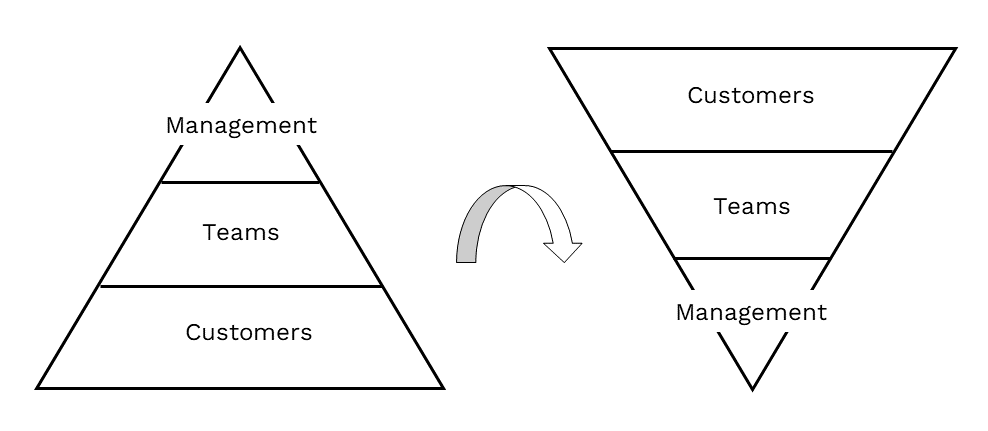Self-organization is a captivating phenomenon that unveils the innate capacity of individuals and entities to collaborate, adapt, and thrive in a chaotic environment. Our immune system is a remarkable example of self-organization. It is a complex network of cells, tissues, and organs working together to protect the body from harmful pathogens without a central control.
In this article, we explore the concept of self-organization in the business context so that you can better understand its potential for your organization.
Understanding self-organization
Self-organization in ancient warfare
Around 400 BC, Xenophon, a Greek aristocrat and general, describes a cooperative leadership model in his book “Anabasis – The Train of the Ten Thousands” that gave his army a military superiority that was overwhelming for the time.
The fact that the Greeks survived the battle against the Persians was thanks to their unique way of making decisions and their ability to reorganize themselves even under difficult conditions. [1]
The existential decisions were not made by the leaders (they were elected and could be removed at any time), but always by the general assembly in a democratic manner. The system of command and obedience that otherwise prevailed in the military was largely suspended here. This organization model was unsurpassed in its time, it was vastly superior to the centralized, strictly hierarchical model of the Persians.
Why self-organization is becoming so important?
The market becoming more and more complex, it is vital for companies to let people who are in direct contact with customers make decisions to improve their value proposition and the way how the work is organized.
Introducing self-organization is required to implement a real customer-centric organization. In the new structure, the management acts as support function of teams to satisfy better the customers as shown on the following figure:

As stated in the Agile Manifesto, the best solutions emerge from self-organizing teams, because they know the best the requirements of the customers.
The new structure enables the teams to adapt faster to changes, as they are directly implemented by the people in contact with the operations. As companies are being more receptive to social and environmental responsibility, distributed decision-making becomes more attractive to accelerate the integration of sustainability practices.
Moreover the best talents aspire to more autonomy. Employees in self-organizing companies often feel more engaged and motivated because they have a greater sense of control over their work and are part of decision-making processes. This increased engagement can lead to higher productivity and reduced turnover rates.
Characteristics of self-organization
Empowerment of employees
Self-organization contrasts with centralized control, which is a hierarchical and top-down approach to decision-making and organization. In a centralized control system, decisions are made by a few individuals or a single authority who direct the actions of others. In contrast, self-organization empowers individuals or entities to make decisions locally based on local information, leading to more distributed and decentralized decision-making.
Self-organization is a mechanism that allows for self-management, as it enables individuals or entities to organize themselves and take responsibility for their actions and outcomes.
Emergent structures
While self-organization can lead to complex and ordered patterns, it is distinct from chaos. Self-organization arises from underlying rules and interactions that generate patterns, structures, and behaviors, even in the absence of external control. Chaos, on the other hand, lacks predictable patterns or order, making it difficult to identify any underlying rules.
Self-organization is a process by which these emergent patterns and structures come into existence without external direction or control.
Holacracy is a form of self-organization
Holacracy is a specific organizational framework that implements self-organization through structured roles, processes, and decision-making mechanisms. In this approach, authority is distributed across “circles” that represent specific domains of work within the organization. Each circle has its defined purpose, and employees are assigned to specific roles within these circles. The decision-making process is based on a governance process that allows roles to be created, modified, or removed as needed. Tactical meetings provide a forum for addressing operational issues and making decisions collaboratively.
Distributed decision authority
While democracy relies on elected representatives who make decisions on behalf of the people based on majority rule, while self-organization distributes decision-making authority among the participants, allowing them to make decisions independently and collaboratively.
The main difference between cooperative leadership and self-organization lies in the distribution of decision-making authority and the level of central control. Cooperative leadership still relies on a designated leader who facilitates decision-making with input from team members, while self-organization distributes decision-making authority across the team members, encouraging them to make decisions independently.
Collective intelligence enhances self-organization
Collective intelligence is the shared problem-solving ability of a group, where individuals collaborate to achieve better outcomes than experts. Collective intelligence enhances the decentralized decision process in self-organized structures by using information which closer to the reality of operations. As a result, the decisions have often a better quality than the ones taken from a central authority.
Levels of self-organization
Self-organization is not relevant for all companies. Companies which are operating in a stable market and and solve simple problems can work very well with a centralized control system. However we see self-organizations enters even the traditional industrial sector. The company Morning Star in the USA which is producing tomato products operates without traditional management hierarchy. Employees negotiate responsibilities with their peers and have the freedom to make decisions related to their work.
Richard Hackman, a Harvard University professor, proposed four levels of authority allocation for teams [2].

- The first level is manager-led teams, where the team is responsible for assigned work but lacks authority over its own processes, which remains with the team’s manager.
- Moving up, self-managing teams have more authority, enabling them to manage their own processes and make decisions about how they work, such as adopting an agile approach.
- The next level is self-designing teams, which have the authority to modify team membership. They can add or remove members, and they may also have authority over reporting relationships within and outside the team.
- At the highest level of authority are self-governing teams. These teams have the power to change their main purpose. For example, they could switch from developing an mobile app for consumers to developing AI applications for businesses.
DB Systel, the IT provider of the German Railway has implemented self-organization close to the level 4. Teams can decide who they are hiring, can select their agility master and decide to change their service offering in agreement with the product owners.
The challenges of self-organization
Reinventing the management role
In a self-organized company, the role of managers undergoes significant changes compared to traditional hierarchical organizations. While the concept of managers may still exist, their responsibilities shift to facilitation and coaching roles. Their primary focus is to support and empower employees, providing them with the resources, guidance, and feedback they need to excel in their roles.
This transformation is the most difficult that a company has to introduce, as managers are fearing to loose status and responsibilities. As demonstrated by the successful companies using self-organization, this change is only successful when they is a strong will from top management.
Not everyone want to have more responsibility
Introducing self-organization means that employees are more involved in the decision process and are co-responsible of the consequences of these decisions. It can be very challenging for people preferring to work only their tasks.
However the majority of employees want to grow personally and are willing to become the most that one can be, following the Maslow’s hierarchy of needs [3].
Adapting the company governance to self-organization
Some companies are working in a strong regulated environment. What happens when a security issue must be solved by all teams without central governance? Will teams do duplicate work or do things completely differently than others?
The traditional way of command and control has to be replaced by full transparency and collaboration to achieve the company goals. In case of urgency, the organization should be able to make fast decisions. Therefore roles are required to arbitrate, in case a consensus cannot be found.
More self-organization means also more conflicts
In self-organizing environments, there is no authority to point the finger to in case of difficulties. The risk of conflicts is a significant challenge due to diverse perspectives, unclear roles, and communication gaps. Competing priorities and power struggles can also contribute to conflicts. To manage conflicts effectively, organizations must encourage clear communication, establish ground rules, and provide mediation and facilitation support. By proactively addressing conflicts, self-organizing teams can turn challenges into opportunities for growth and innovation.
Team development is essential to promote cooperation and trust among team members. Trust and conflict resolution skills should be regularly assessed, for example with our team health checks and with our skill matrix, to ensure that the team has the foundation to effectively solve conflicts.
Conclusion
Inspired from the nature, self-organization in the business context is a very powerful mechanism that enable companies to adapt more quickly to complexity and volatility. It replace the traditional command and control paradigm by a decentralized decision process and emerging rules and structures.
As many company want to become more sustainable and have a better engaged workforce, this model becomes more and more relevant.
It requires a strong will from top management to switch from centralized control to self-organization, as it impacts profoundly the roles and responsibilities of employees. Moreover, a mindset change is required, switching from the “leader-follower” to the “leader-leader” principle. This shift can only be effective with adequate training and coaching of employees.
Image by Freepik
References:

